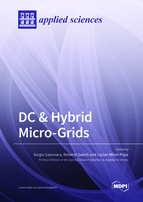DC & Hybrid Micro-Grids
A special issue of Applied Sciences (ISSN 2076-3417). This special issue belongs to the section "Energy Science and Technology".
Deadline for manuscript submissions: closed (30 September 2019) | Viewed by 34818
Special Issue Editors
Interests: automotive electronics; embedded HPC (high-performance computing); enabling technologies IoT (Internet of Things)
Special Issues, Collections and Topics in MDPI journals
Interests: intelligent controllers and energy management; power converters and control; power electronics for energy access; electric vehicles: drivers and charging; model predictive control for power converters; electrical machines and motor drives for transportation electrification
Special Issues, Collections and Topics in MDPI journals
Interests: energy storage; battery managements systems; supercapacitors/Li-based batteries; digital electronics and embedded systems for smart grid
Special Issues, Collections and Topics in MDPI journals
Special Issue Information
Dear Colleagues,
Microgrids are emerging as a suitable, reliable, and clean solution to integrate distributed energy sources, which include energy storage systems (ESSs) and active loads. Microgrids can include both AC and DC distribution lines, acting as a cluster of interconnected distributed energy resources (DERs). Although up to now the AC microgrid has been the most-used solution, thanks to the evolution in power electronics and in energy storage technology hybrid AC/DC microgrids are becoming the optimal approach. Indeed, they combine the main advantages of both AC and DC microgrids, with the integration of smart and digital grid devices and technologies in real-time operation. For example, with respect to AC approaches, DC-based microgrids allow for lower [DM1] issues, in terms of reactive power, frequency synchronization, and integration with an increasing number of DC loads.
To address this important topic, the proposed Special Issue calls for papers presenting:
- -distribution and energy storage management/control systems for hybrid microgrids;
- - recent advances in power electronics for microgrids and particularly in AC/DC, DC/DC and DC/AC converters and solid-state transformers;
- - embedded systems and networking for microgrids towards the foundation of an “Internet of Energy”;
- - predictive diagnostic and functional safety techniques for microgrids.
The latest developments and ongoing research and innovation activities related to microgrid controllers to improve the performance of distribution power grids are also welcome. Submissions about renewable energy systems or hybrid/electric vehicles, but with a relation to DC and/or AC microgrids, are also welcome.
Prof. Dr. Sergio SaponaraProf. Dr. Lucian Mihet-Popa
Prof. Dr. Roberto Saletti
Guest Editors
Manuscript Submission Information
Manuscripts should be submitted online at www.mdpi.com by registering and logging in to this website. Once you are registered, click here to go to the submission form. Manuscripts can be submitted until the deadline. All submissions that pass pre-check are peer-reviewed. Accepted papers will be published continuously in the journal (as soon as accepted) and will be listed together on the special issue website. Research articles, review articles as well as short communications are invited. For planned papers, a title and short abstract (about 100 words) can be sent to the Editorial Office for announcement on this website.
Submitted manuscripts should not have been published previously, nor be under consideration for publication elsewhere (except conference proceedings papers). All manuscripts are thoroughly refereed through a single-blind peer-review process. A guide for authors and other relevant information for submission of manuscripts is available on the Instructions for Authors page. Applied Sciences is an international peer-reviewed open access semimonthly journal published by MDPI.
Please visit the Instructions for Authors page before submitting a manuscript. The Article Processing Charge (APC) for publication in this open access journal is 2400 CHF (Swiss Francs). Submitted papers should be well formatted and use good English. Authors may use MDPI's English editing service prior to publication or during author revisions.
Keywords
- Distribution and Energy Storage Management Systems
- Control Strategies for Microgrids
- Power Electronics and Power Converters
- Embedded Systems (MCU/PLC/FPGA/DSP) for Microgrids
- Wireless Power Transfer
- Recharge of Electric and Hybrid Vehicles
- Networking for SmartGrid and Internet of Energy
- DC and Hybrid Microgrids
- Renewable Energy Systems Monitoring &Control
- Predictive Diagnostic and Functional Safety for Microgrids








